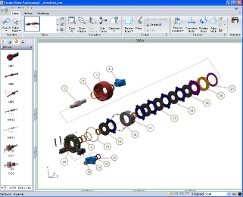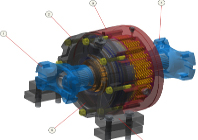PTC held its Annual Media and Analyst day in a rather chilly Boston last month. I’ve been hopping over the pond for this event for a couple of years now and there’s always some good industry nuggets to be found, as well as getting a sneak peek at what’s coming from PTC in the next twelve months. PLM has been a driving theme for many years, but this year the stakes were raised, evident from the event’s tagline of “Conquering PLM.” Apparently, this means “getting credit for being the clear leader” and PTC seemed to be rather annoyed that it’s not being given the credit as the leader of the industry. The way in which the executives seemed more than a little aggrieved was quite surprising.
PTC stated that PLM has ‘come of age’ with a greater number of companies looking to build their infrastructure for the future. This was backed up by news that the company had experienced a 137% license growth in PLM in Q1 2010, compared to last year, with a projected 30% growth over the full year. These may appear solid figures but it should be taken into account that the company’s 2009 PLM revenues were down by 25% on 2008.

PTC is in the late stages of development of a new technical illustration package which uses its ProductView and Isodraw technologies to compete with the likes of Dassault’s 3DVia Composer
The company’s license growth in PLM software does not appear to be directly from within its customer base, with reports of many companies adopting Windchill-based products that weren’t already Pro/Engineer customers. As Jim Heppelmann, chairman and chief operating officer, PTC explained, “These aren’t existing customers that we sold more stuff to,” quoting EADS, Nokia, GE, and IKEA. “People that started with somebody else’s product and switched to ours somewhere along the way.
“Every time we announce that a big customer switched, it makes it easier to convince the next big customer to switch.” Heppelmann referred to this as the domino effect and keeps this separate from sales into existing customers (citing the John Deere deal).
Following the stage presentations I got to sit down with Heppelmann and talk through some of the key topics and product directions discussed at the event.
The Cloud
One subject that had been on the tip of everyone’s tongue following SolidWorks’ user event the previous week, was ‘The Cloud’, an area that PTC has been ahead of the curve on for some time with it’s PLM OnDemand offering in conjunction with IBM. I asked Heppelmann what he thought about the recent announcements and tech demos.
“Clouds are made of vapour,” he said. “People have spinned it out of control. It’s just another way to deliver software. If it works, they’ll buy it. If it doesn’t work, they won’t buy it. That’s why most people aren’t buying it.”
When asked about the barriers to adoption, Heppelmann replied, “Part of it’s emotional, part of it’s technical, but people are saying ‘It would be great if I didn’t have to install any software or worry and I was instantly in production but if it means it takes an extra 30 minutes to download an assembly I want nothing to do with it. If it means there’s a chance my data might get compromised by my competitor, I want nothing to do with it.’ Those are real problems.

Jim Heppelmann, PTC’s Chairman and Chief Operating Officer
“If you’re in a big company and you have 50 applications in your data centre and you put one in the cloud – nothing changes. It’s not like suddenly your whole IT department is super-productive, because you’ve got the other 49 applications – can you put those on the cloud? No. Probably not. I just think this whole cloud thing has blown so out of control. It’s like SaaS, SOA – It’s all magic pixie dust to solve all of our problems when it’s really just… tools. Sometimes they work, sometimes they don’t.”
Technical Publications
From various noises coming out of the event, it was clear that PTC is working on something new for the technical publications space. The developments centre on taking PTC’s existing Arbotext and Isodraw products and linking them to a web-based delivery mechanism. This was referred to as Service Information Solutions (SIS). Alongside this, there appears to be a new product that combines the company’s expertise in technical illustration through Isodraw with its ProductView lightweight visualisation technology.
Heppelmann was very animated about PTC’s SIS development, “I think we have an opportunity to reinvent how after-market service is done and I’m very excited and personally drove this change to start thinking about more efficient ways to create manuals – and to start thinking about more efficient ways to do service processes. We realised that manuals aren’t efficient in the first place. If you develop something to make something more efficient that’s not efficient in the first place, what do you gain?”
ProductPoint
Last year’s event was all about the release of PTC’s ProductPoint. This was a system that took lessons learned with Windchill and combined it with SharePoint to create a data management and collaboration environment – or to use PTC’s words, Social Product Development.
I think (ProductPoint)becomes important as we get much bigger volumes and as we penetrate the SolidWorks and Inventor base with it.”
Jim Heppelmann, Chairman and Chief Operating Officer, PTC
So how was ProductPoint performing in the year since its launch? Heppelmann said that the original goal was to sell the system to 100 companies in the first 12 months and that target was exceeded by 40. This year’s goal is 300, but after just one quarter they’ve already hit 100, so are more than on target for 2010.
I asked Heppelmann about how important ProductPoint was to PTC, “From a revenue standpoint, it’s not yet that important because it tends to be small deals because that’s what we designed it for. So I think it becomes important as we get much bigger volumes and as we penetrate the SolidWorks and Inventor base with it.”
What about Pro/Engineer?
There was very little discussion of Pro/Engineer and with the software now on a 24-month release cycle and Wildfire 5.0 launched in Autumn 2009, this was to be expected. I did manage to catch up with Brian Shepherd who heads up the development effort and we quickly discussed the Wildfire 6.0 release. While there will be the usual enhancements, the key feature set that people are interested in comes from the merging of the CoCreate direct modelling technology within Pro/Engineer.
While Brian admitted that CoCreate users are a loyal bunch, the team is looking to combine the toolsets to offer them a compelling reason to make the leap. It was also interesting to hear his views on the benefits of using the Pro/Engineer geometry kernel as the basis for direct modelling.
Products like CoCreate operate within very specific topological limits (i.e. it doesn’t handle them too well). According to Shepherd Pro/Engineer’s geometry kernel handles topology changes in a much more robust manner. This sounds interesting and I’m sure we’ll learn more later this year.
Conclusion
PLM is a business concept that’s gaining traction. We know this from talking to our readers. Products are increasingly complex, processes are increasingly complex, and supply chains are increasingly complex – across all industry sectors. In the last few months PTC has announced some pretty major deals for Windchill that has seen its revenues swell in that sector – I seem to recall that last year’s poorer financial results were the result of delayed orders so by moving into this financial period has helped fuel that growth.
But alongside all of the posturing around PLM, for me, the most interesting news out of the event was the work the company is doing in the technical service information field. Most other vendors seem to ignore it or have point solutions (Dassault/SolidWorks has 3DVia Composer and Autodesk is previewing its technical publications technology) that focus on the illustration side of things. But the fact is that the illustration technology is a small component of a very complex process.
At the event, a gentleman from Komatsu, a mining and construction equipment manufacturer, went through the result of his company’s transition from a FrameMaker-based process to one based on Arbortext and Isodraw. Komatsu is expecting to save 50% in translation costs and this is huge considering that the addition of Spanish translations of their manuals cost in excess of $1 million. On top of this it will no longer outsource illustrations which cost over $120,000 per year and it will also benefit from a reduction in cycle time and repetition of work. That’s a pretty compelling pitch to anagement to invest in a technology that fits a need, reduces a serious financial outlay and adds value. For me, that’s where the action will be in the coming year. Let’s see what comes of it.
www.ptc.com

Al Dean reports on the latest developments from industry giant PTC






